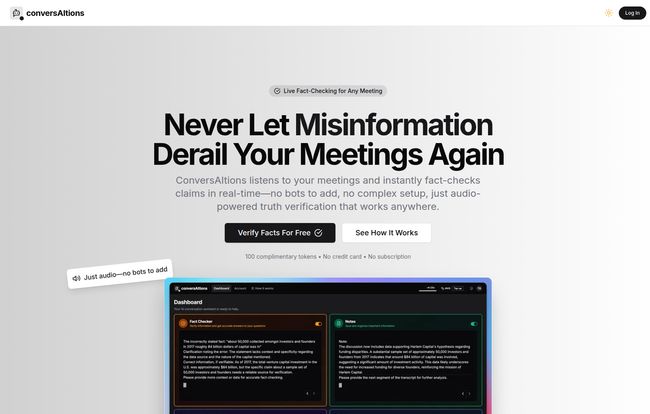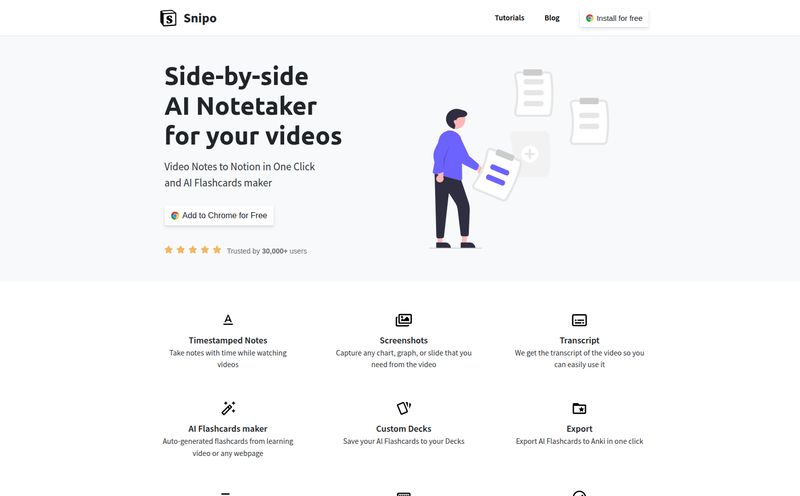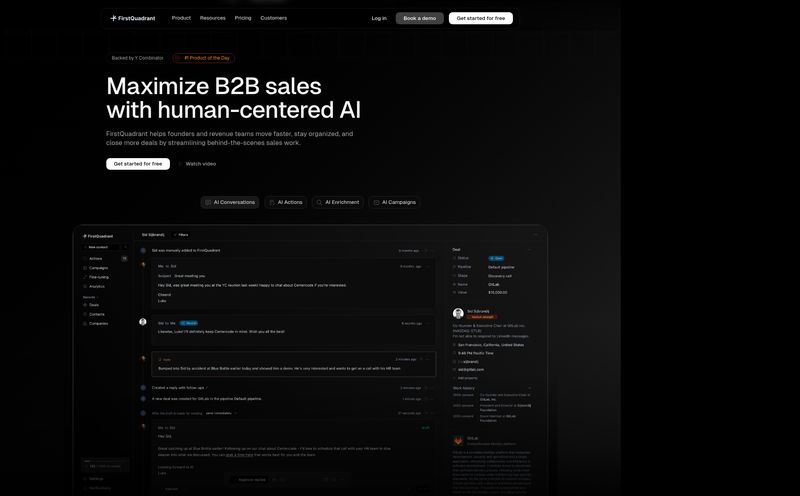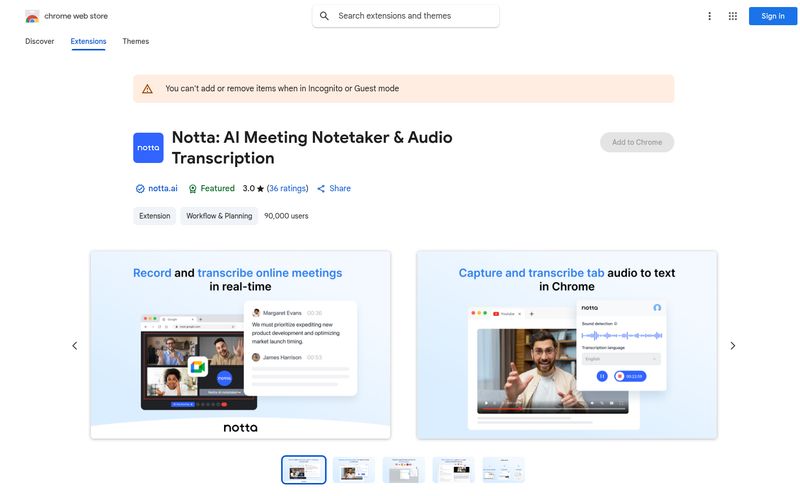We’ve all been in that meeting. The one where a colleague, with the confidence of a thousand suns, states a “fact” that makes your internal monologue scream, “Wait, is that actually true?” You’re stuck. Do you interrupt the flow and potentially embarrass them (and yourself if you’re wrong)? Or do you just nod along, letting a piece of potential misinformation slide into the foundation of your project? It's a terrible choice.
For years, I've just accepted this as a part of corporate life. But lately, the wave of AI tools has promised to solve every little problem we have. Most are just hype, but every now and then, something genuinely interesting comes along. That's what happened when I stumbled upon a tool called ConversAItions. Its claim is simple but bold: to be a real-time AI conversation copilot that fact-checks, takes notes, and even prompts you with smart questions, all without being an intrusive bot in your call. Sounds too good to be true? That’s what I thought, too. So I took it for a spin.
What is ConversAItions, Really?
Forget inviting another clunky bot to your Zoom or Google Meet. That’s the first thing you need to know. ConversAItions isn’t a participant; it’s your own personal sidekick. Think of it less like a meeting recorder and more like a silent, hyper-intelligent research assistant sitting on your shoulder, listening to whatever audio is coming out of your computer.
It uses powerful AI models (like the much-talked-about GPT-4) to process the conversation in real time. It’s designed to be a copilot, not the pilot. It gives you the intelligence you need to steer the conversation, make informed decisions, and call out bluffs—politely, of course.
The Core Features That Actually Matter
A lot of AI tools are a laundry list of features that sound cool but you never use. I found that ConversAItions really boils down to three things that make a difference.
Real-Time Fact-Checking: Your Personal Truth Serum
This is the headline feature, and for good reason. As people talk, the tool listens. If someone drops a statistic, a date, or a verifiable claim, ConversAItions gets to work. A few moments later, a little notification will pop up on your screen, either confirming the claim with a source or gently flagging it as potentially inaccurate. It’s like the pop-up facts from an old VH1 show, but for your actual life. Imagine being on a sales call and a prospect claims a competitor offers a feature for half the price. Instead of scrambling, you get a quiet confirmation (or denial) right on your screen. That's power.
Automatic Notes Without the Frantic Typing
I loathe being the designated note-taker. You’re so busy trying to capture what was just said that you completely miss the next three points and can't actually think about the topic. ConversAItions tackles this by generating automatic notes. It’s pretty good at identifying key points, action items, and important decisions. This frees up your brain space to, you know, actually contribute to the conversation. It's not perfect, but it's a massive improvement over a blank page and a blinking cursor.

Visit ConversAItions
Smart Prompting: The Nudge You Didn't Know You Needed
This was the feature that surprised me the most. Based on the flow of conversation, the tool will suggest relevant follow-up questions. Ever been in an interview or a deep discussion and your mind just goes blank? This feature is a lifesaver. It can help you dig deeper or explore an angle you hadn't considered. It’s like having a tiny, invisible coach whispering in your ear, “Ooh, ask them about the Q3 budget allocation for that project.” It helps you sound smarter and stay more engaged, which is never a bad thing.
The Money Talk: ConversAItions Pricing Explained
Alright, so how much does this digital wizardry cost? This is where it gets a little different. ConversAItions operates on a token-based system, which can be both good and bad. Here’s the breakdown:
| Plan | Cost | Key Details |
|---|---|---|
| Standard | Free to Start | You get 100 complimentary tokens. Fact-checking uses 2 tokens per 30-second interval. Good for a trial run. |
| Bring Your Own API Key (BYOAK) | Pay-as-you-go via OpenAI | Connect your own OpenAI API key. This cuts token usage by 50% (only 1 token per fact-check per 30s). This is the power-user move. |
My take? The 100 free tokens are the perfect way to test it out without commitment. You can get a real feel for it across several meetings. If you find yourself relying on it, connecting your own OpenAI key is a no-brainer. It gives you way more control and is much more cost-effective in the long run.
My Honest Take: The Good and The Not-So-Good
No tool is perfect. After using it for a bit, here's where I think ConversAItions shines and where it stumbles.
The Good Stuff
The sheer seamlessness of it is the biggest win. There’s no setup friction, no begging the meeting host to approve a bot. It just works. The confidence it gives you is palpable. As one of their testimonials from Alex Rivers notes, meetings become "40% shorter but twice as productive," and I can see why. You cut through the fluff and get right to the point. It’s also just... cool. It feels like you're living in the future.
Potential Hiccups
The token system, while fair, does make you feel like you're at an arcade, constantly aware of the meter running. But the biggest caveat is this: the tool's efectiveness is entirely dependent on audio quality. This is classic GIGO (Garbage In, Garbage Out). If someone is speaking through a laptop mic that sounds like they're in a wind tunnel at the bottom of the ocean, the AI is going to struggle. It needs clear audio to do its job properly. This isn't really the tool's fault, but it's a real-world limitation you have to consider.
Who Is This AI Copilot Actually For?
I can see a few types of professionals getting a massive benefit from this:
- Journalists & Researchers: Being able to fact-check claims during an interview in real-time is a complete game-changer.
- Sales & Account Managers: Keep track of client promises, verify competitor claims, and never miss an action item from a call again.
- Project Managers & Team Leads: Cut through vague status updates and get to the truth. Ensure everyone is on the same page with auto-generated notes.
- Students & Academics: Imagine using this during a dense lecture or a fast-paced study group. It could be an incredible learning aid.
The Verdict: Should You Try ConversAItions?
So, should you let this AI into your professional life? In my opinion, yes, absolutely. At least give the free version a shot. It's not a magic wand that will solve all your meeting woes, but it is a uniquely powerful tool for enhancing truth and clarity in conversations. In a world increasingly filled with noise, misinformation, and now AI-generated deepfakes, having a personal, real-time fact-checker feels less like a gadget and more like a necessity.
The 100 free tokens are more than enough to see if it fits your workflow. What have you got to lose? A bit of misinformation, perhaps?
Frequently Asked Questions
Does ConversAItions record my meetings?
No, it's not a traditional recording tool. It processes the audio in real-time to provide its features like fact-checking and notes, but it's designed for live assistance, not for creating an audio or video file of your meeting for later playback.
How accurate is the fact-checking?
The accuracy is very high, as it's powered by models like GPT-4. However, its accuracy depends on two things: the clarity of the audio and the nature of the claim. It excels at verifying objective facts (dates, stats, public information) but can't verify personal opinions or private company data.
Is it difficult to use my own OpenAI API key?
If you're not a developer, it might sound intimidating, but it's pretty straightforward. OpenAI has simple guides on how to generate an API key from your account. You just copy and paste it into the ConversAItions settings. It takes about two minutes.
Can the tool tell who is speaking in the meeting?
Currently, the main focus is on processing the content of the conversation as a whole, rather than on speaker diarization (identifying who said what). It treats the audio input as a single stream of information.
What platforms does it work with?
Since it works by listening to your system's audio output, it's platform-agnostic. It works with Zoom, Google Meet, Microsoft Teams, Slack Huddles, or even an in-person conversation if your microphone is picking it up. It runs on your computer, not in the meeting platform itself.
Reference and Sources
- ConversAItions Official Website
- OpenAI Platform (for API Key information)



